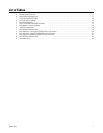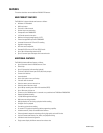
C2629M-A (6/07) 11
Description
The DX8100 Series digital video recorders (DVRs) are professional security-level DVRs based on a new and innovative hardware platform that is
powered by unparalleled and unique high-performance software. As the security requirements of your business expand into multiple sites and
become more diversified, you need a professional DVR that you can quickly and effortlessly increase the channel and recording capacity.
• The DX8100 is interoperable with your existing DX8000 DVRs, allowing you to build upon your existing security system. A DX8100 client
can operate and administer both the DX8100 and DX8000 within the same network.
• When you need to quickly and easily add more security cameras, the new DX8100-EXP 16-channel expansion unit extends the 8- or
16-channel DX8100 to 24 or 32 channels. With or without the channel expansion unit, all of the cameras can now take advantage of the
increased frame rate of 2CIF and 4CIF recording. The DX8100 records video up to 480 images per second ips at a maximum CIF image size.
• If your security project requirements increase storage capacity, you can extend internal storage up to 3 TB. With the optional DX9200 HDDI,
you can further increase the DX8100 storage capacity. Alternately, you can use the DX9200 HDDI as a redundant RAID solution.
• As your audio security needs grow, use the DX8108-AUD or DX8116-AUD audio option to add a total of 8 or 16 audio inputs.
• Sophisticated video security applications require a network of DVRs to monitor multiple locations. The 10/100/1000 megabit Ethernet port
supports today’s high-speed networks. You can network your DX8100 and DX8000 systems and remotely operate the DVRs for continuous,
motion detection, alarm, ATM/POS, normal scheduled recording, and administer and view live and playback video. For time-critical security
applications, you must ensure that all video recordings are synchronized to an accurate time source. The DX8100 supports the network time
protocol (NTP), which allows you to synchronize all networked DX8100s to one NTP time server.
WHAT IS A DVR?
A DVR is a video recording and playback device that incorporates all of the essential capabilities of a VCR but adds significant advantages. Like
a VCR, video is recorded (from one or more cameras) and stored for later playback and retrieval. However, in a DVR, video data is recorded and
stored on a hard disk instead of magnetic tape. Storing video in this manner facilitates instant, random access to data, as opposed to sequential
access inherent to tape-based recording. This means no fast-forwarding or rewinding is necessary to locate the data a user wants to view or
export.
Another key advantage of hard disk is decreased maintenance. With no need to replace tapes, DVRs with hard disks can be left unattended for
extended periods of time. Since video remains in the digital domain, data is easy to store, transport, and manipulate. Unlike analog video
recordings, digital data does not suffer from a loss in quality when copied or moved from device to device.
Because DVRs rely on hard disks instead of tape, data storage is virtually unlimited. Video data can also take advantage of compression
technology to increase the efficiency of storage media. Modern DVRs, such as the DX8100, allow users to record, play back, and view live video
simultaneously. Keeping data in a digital format means video can be easily backed up to a variety of storage media. This also means that
alphanumeric information, such as date, time, and transaction statistics, can be synchronously recorded with video.


















